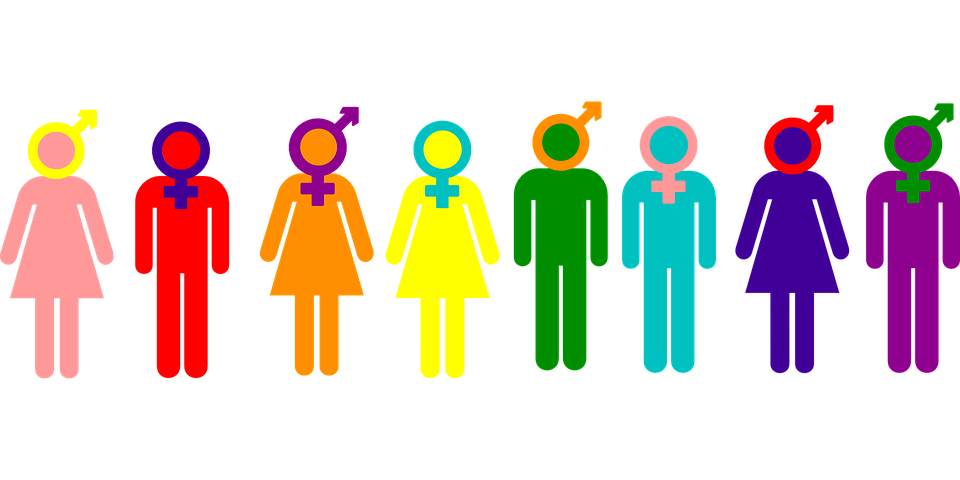
BUFFER ZONE

In the male-dominant society in the U.S., categories other than White, middle class men bear the characteristics that define the Other. That fact alone sets the bar at the hegemonic level of masculinity and dictates relationship roles in both masculine subordinates and women in a traditional and antiquated patriarchal social pecking order.
On a global scale, the difference between men and women is the degree of subordination. Emphasized femininity is defined as the most compliant in subordination to men. Others are labelled according to complicated combinations of non-compliance, resistance, compliance, or cooperation. The interacting combinations continuously change the dynamics of gender in the workplace, and changes in gender across sexes further complicates the on-the-job hierarchy.
It follows that trans people are targeted with mental or physical violence in the workplace more than any other minority. According to the findings of Sugano, Nemoto, and Operario in their 2006 study, transgender respondents perceived their job losses or failures to advance in their careers as due to their open performance of gender. The researchers identified this as a sociocultural trend of marginalization and/or exclusion of transgendered persons on the job. They also determined that the oppression of prejudice and discrimination born by trans people stems from and is inflicted out of a social attitude called transphobia.
In relation, the term cisnormativity represents an assumption of cisgender as the norm, which creates a terrific lack of representation for trans people and fosters the belief that they do not or should not exist. It’s also thought to be the foundation of transphobia since it causes fear for want of understanding. People are scared of things that they do not understand, and it is takes more effort to achieve an understanding than it does to dismiss, marginalize or oppress.
Although a different light has shone on the trans community over the course of the last decade and it’s been recognized recently through small screen television triumphs, in the world off screen trans people are not so easily spotted. In fact, they are almost invisible in the business world. Few transgender individuals have the financial means or support to make trans-life easy and the vast majority have, or will have, suffered discrimination and mistreatment in places of traditional employment. Trans people have been forced to endure basic and fundamental challenges in the pursuit of employment and therefore, it is understandable that trans people are more than twice as likely to face long-term unemployment, and are at greater risk for poverty because of it.
Results of a 2011 study conducted by the National Center for Transgender Equality and National LGBTQ Task Force, concluded the number of trans people who reported discrimination, harassment or mistreatment at work equaled 90 percent. Included in that 90 percent were individuals who actively hid to avoid being victimized. Additionally, more than a quarter of those studied suffered job losses directly related to their transgender or gender non-conformist states.

Photo: Creative Commons
It can be deduced without effort that, for the transgender individual, technology can offer a substantial buffer. Some tech companies now strive to employ trans individuals online where they find empowerment in more friendly environments. Opportunities are becoming available (through technology) that are leveling the playing field for those who, perhaps unpassable, would not in this day and time be considered in many physical worksites. Individuals can learn skills online and work in dignity on their PCs and Macs without the daily stressors and anxieties that have historically plagued the lives of many transgender persons in the workforce.
Angelica Ross, as the founder of TransTech Social Enterprises, uses her company to empower trans and gender queer people by teaching them workplace skills through on-the-job training.

Angelica Ross photo: USA Today
Having walked away from the life of a showgirl to run a design agency for a few years, she eventually launched the TransTech’s apprenticeship program. With no help from investors or grant monies, Ross used the proceeds from a brief fundraiser to fund one 12-week pilot program for two participants. It was all that she had, but a few nonprofit donors came forward and offered sponsorships for others. At present, the business can afford small weekly stipends for its apprentices, and anticipates that each apprenticeship participant will develop a skillset that will allow them to fully support themselves as independent contractors. According to Ross, “Having a skill can make you undeniable.”
That the technology industry underwent struggles in the initial shifts from a dominant White male workforce is undeniable, and it’s notable that its escalating involvement in matters of racial and female equality often left transgender issues of diversity overlooked or totally ignored.
However, a lot has changed when you consider IBM’s current policy on diversity, which protects its workers against discrimination for sexual orientation or gender identity. IBM fired their chief microelectronics pioneer, Lynn Conway, for her decision to transition from male to female in 1968.
For a long time the high-profile dismissal of Conway represented a warning flag to transgender tech employees. However, in a 2016 article in USA Today, Yahoo product manager, Amy Hackenberger, expressed a feeling of acceptance in the technological workplace as a transitioning trans woman. At the time of the article, she had not reached a point of passing. She confessed to initial fears of using the women’s restroom on the job, but she met no censure or undue notice from the other women. Hackenberger expressed gratitude to be employed in an industry that allowed her to forget that she was transitioning on a daily basis.

Amy Hackenberger Yahoo! Photo: USA Today
The technology industry allows her a sense of community among peers as well as the ability to normalize the performance of her gender.
Today in the state of Texas, it is not illegal to fire someone for gender or sexual orientation issues. Indeed.com operates from that state under an aggressive policy of non-discrimination, going so far as covering surgeries for those seeking gender reassignment.
According to Nicole Sanchez of GitHub, 2 percent of her company’s employees are trans, and she is of the opinion that corporations not actively recruiting around the inconveniences of trans employees are overlooking a huge talent resource. There is a professional freedom at the keyboard where transgender people can express themselves without worry of judgment or fear for their personal safety.
In the buffer zone of the tech industry, one is as likely to be fired for being transgender as for reporting to work out of uniform. It’s just not happening.







